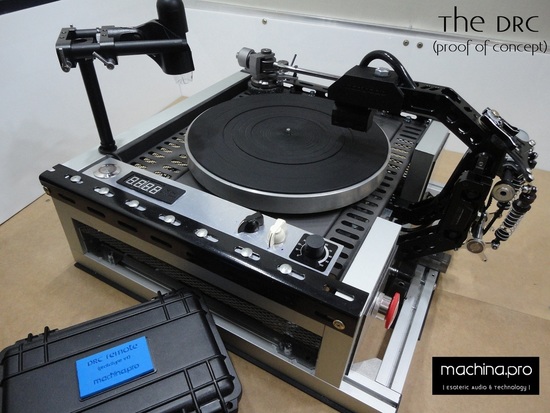 A Prototype of the DRC. Photo: kickstarter.com
A Prototype of the DRC. Photo: kickstarter.com
In 2014, vinyl sales went up 52 per cent from 2013 (Nielsen SoundScan). The resurgence of this seemingly out-dated technology signals an unexpected development in the digital era. In an era when music is more accessible than ever--with music players built into every phone--it may seem odd that people are returning to the most expensive and least convenient way to appreciate music. In many ways, the record revival is a response to the various downfalls of digital music players: sound quality, the listener's attention, and pride of ownership. Although the market for records is evident, the craft of cutting vinyl remains a specialist trade with incredibly high production costs. The Desktop Record Cutter intends to innovate this craft.
Once produced, the DRC will make cutting records easier, less expensive, and more available to the general public. The DRC is a Kickstarter project that recently tripled their $10 000 pledge goal. Many retailers carry new record players with USB capabilities, although many new records cost upwards of $20--and more for limited runs. The DRC will allow musicians to produce records with a lower cost margin, and as a result, record enthusiasts will have a wider variety of new music available to them at a lower price.
Paul Taya, creator and CEO began creating the DRC for personal use before realizing the market for such a product. Paul Taya is an Australian-based audiophile, record fanatic, and mad scientist. The DRC uses plastic, rather than the much more toxic and flammable lacquer--using plastic makes the record cutting process safer in a desktop environment. Today, records are typically pressed on 150 or 180-gram vinyl (rather than 120 grams), which is meant to raise the sound quality and durability, although it also disproportionately raises the production cost. It is uncertain how plastic would impact the sound quality of the record. However to draw a comparison to record player production, many new record players have adopted an alternative to the crystal needles that were traditionally used, in favour of a more cost effective design, and perhaps arguably, without sacrificing the sound quality.
The DRC will be both portable and affordable. Lower production costs means cheaper records for the consumer. The craft of cutting vinyl is incredibly complicated and the DRC makes the process user-friendly. Although the projected retail price is around $6500 this is a mere fraction of the traditional record cutting machines, which can cost up to $50 000 and take up large rooms. Furthermore, the DRC's projected price is roughly equal to pressing two 500-record runs through Standard Vinyl (standardvinyl.com). Today, getting records pressed, "isn't realistic, logistically," describes Brahma Blue, engineer and producer at IG Studios. Many new artists who would prefer to showcase their music through this medium, but don't have the monetary resources to do so, are subjugated to digital releases. With the DRC, underground musicians will have a better opportunity to get their music spinning on fans' record players.
Technology plays an important role in music and the music industry. The 7" E.P. created a culture of Pop singles; in the 80s, mass-produced recording equipment saw an influx of sampled sounds that would play an important role in the Hip-hop aesthetic; like the 7" E.P., the digital era allowed artists to easily release singles, rather than CD albums. The revival of records demonstrates a desire to return to album releases. By releasing a proper record, bands benefit from the physicality of the product and the attentiveness of the record listener. The Desktop Record Cutter will eliminate the other logistic flaws of this not-so-niche medium.
Although the DRC is still far away from the shelf at your local music boutique, this invention indicates that the prospering vinyl industry may be more than a millennial fad. There are many benefits to analogue music. To make an analogy, a typical film picture is the equivalent to approximately 10 million digital pixels, but even as digital photography approaches this resolution, digital photographers prefer to mimic the effects of shooting on film. Like film photographs, records are full of quirks--crackling, pops and hisses. However for many, these aren't imperfections but characteristics. There's decisiveness in pulling a record off the shelf, placing the needle on the record, and dedicating yourself to an album.
For more details on the DRC, click here.
Leave a comment